Origin and Evolution of Yue Wares
Overview
The Yue Kiln, renowned for its exquisite celadon production, represents a pinnacle of ancient Chinese ceramic artistry. Emerging from the primitive porcelains of the Shang and Zhou dynasties, it matured during the Eastern Han, flourished through the Three Kingdoms, Jin, and Southern Dynasties, reached its zenith in the Late Tang-early Tang period, and gradually declined after the mid Northern Song. Yue celadon, celebrated for its jade-like glazes and elegant forms, reflects both technological innovation and profound cultural shifts across centuries.
Key Historical Periods and Developments
1. Origins and Early Development (Warring States to Eastern Han)
- Warring States Foundations: Recent archaeological discoveries in Deqing, Zhejiang, have unearthed high-quality ritual porcelains from this period, with some meeting early celadon standards, suggesting an earlier inception of celadon technology than previously thought.The Deqing Original Porcelain Kiln Complex in Zhejiang Province is recognized as the earliest known site of green glaze (celadon) production in China, with a history spanning nearly 3,000 years from the Shang dynasty to the Song dynasty. Archaeological discoveries at key sites—Huoshaoshan, Tingziqiao, and Shuidongwu kilns—have unearthed high-quality imitation-bronze celadon ritual vessels, showcasing advanced craftsmanship and glazing techniques from as early as the Shang and Warring States periods.
- Eastern Han Maturation: Among the earliest datable Yue celadon are a celadon well and censer from an Eastern Han tomb (Xiping 4th year, 175 CE) in Fenghua, Ningbo, Zhejiang. These pieces feature grayish-white clay bodies, bluish-green glazes, and minimal decoration, reflecting a refined, understated aesthetic. Forms such as double- and quadruple-lug jars exemplify the Eastern Han Yue Kiln's elegant simplicity. Abundant porcelain stone resources in southern China, combined with expertise in stamped pottery and proto-celadon, facilitated advancements in dragon kilns and led to the mastery of mature celadon.
- Technological Breakthroughs: Abundant porcelain stone resources in southern China, paired with the development of the dragon kiln, laid the foundation for the transition from primitive porcelain to mature celadon ware.
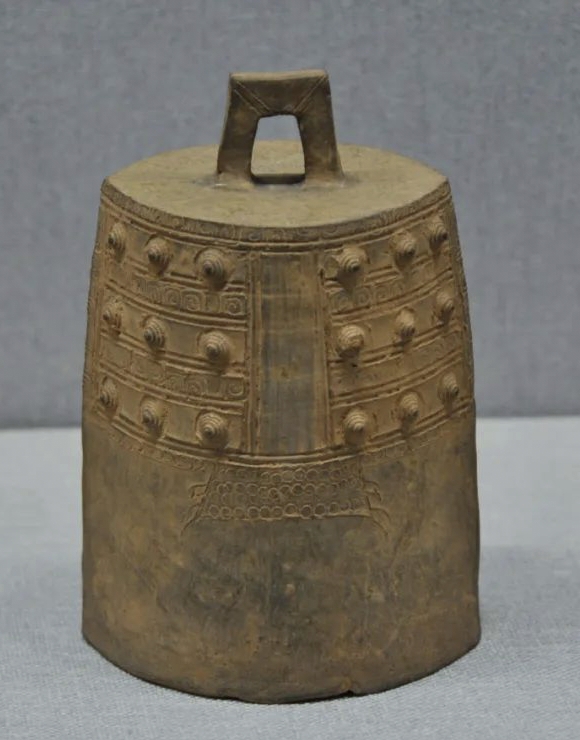 |
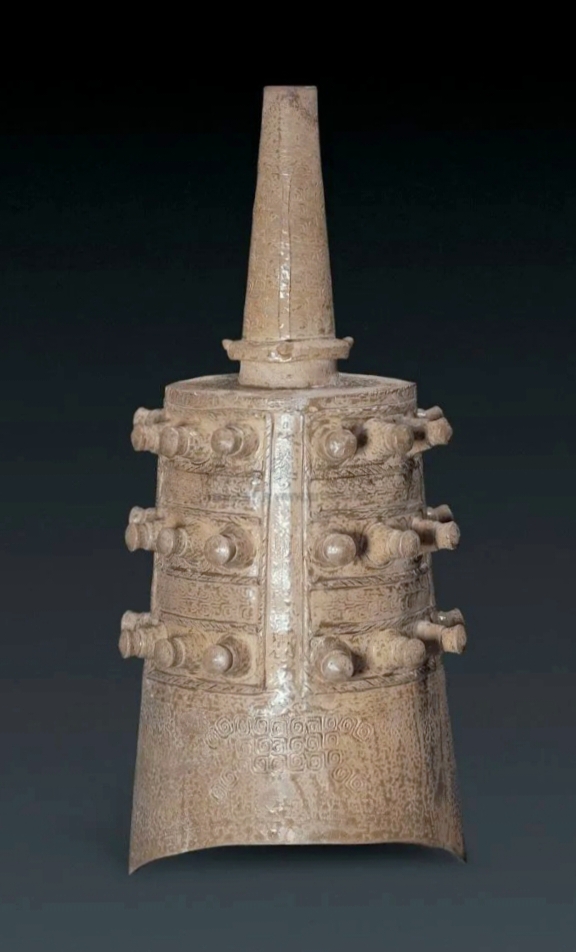 |
| Warring States Musical Instruments |
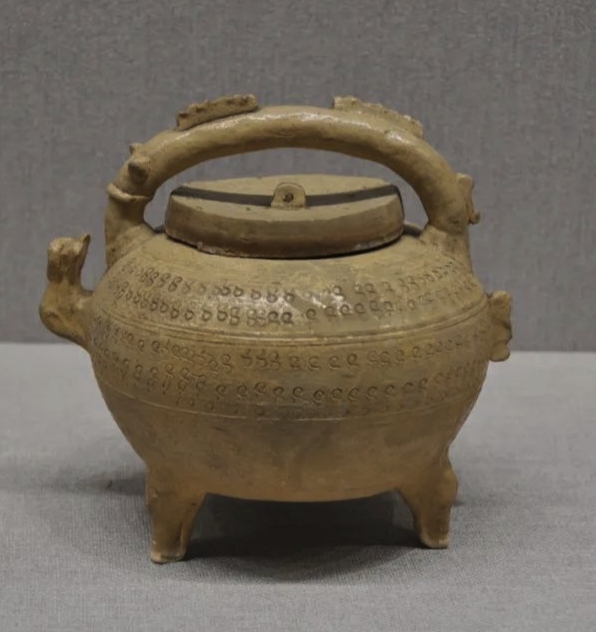 |
| Warring States Wine Vessel |
|
|
| Eastern Han Celadon Pot in Shanghai Museum |
2. Flourishing of Celadon: Three Kingdoms and Western Jin (220–316 CE)
- Technical Refinement: During the Wu Kingdom, Yue Kiln celadon reached new heights of refinement. Vessels typically had dense grayish clay bodies and even, lustrous glazes. Early decorative motifs included water ripple, string, and leaf vein patterns, while later works introduced more complex designs such as diagonal grids and sculptural embellishments.
- Iconic Forms: The period saw the emergence of distinctive forms, including animal-shaped vessels (e.g., tiger-shaped jars, lion figurines) and relief-molded jars depicting scenes of social life. Inscriptions such as "Kuaiji Shangyu" on jars identify Shangyu, Zhejiang, as a key production center.
- Burial Culture Influence: The lavish burial customs in political hubs like Nanjing fueled the mass production of both ritual and daily wares, including censers and miniature wells, demonstrating the integral role of celadon in funerary practices.
|
|
| Three Kingdom Celadon Granary (Wuzhou) in Shanghai Museum |
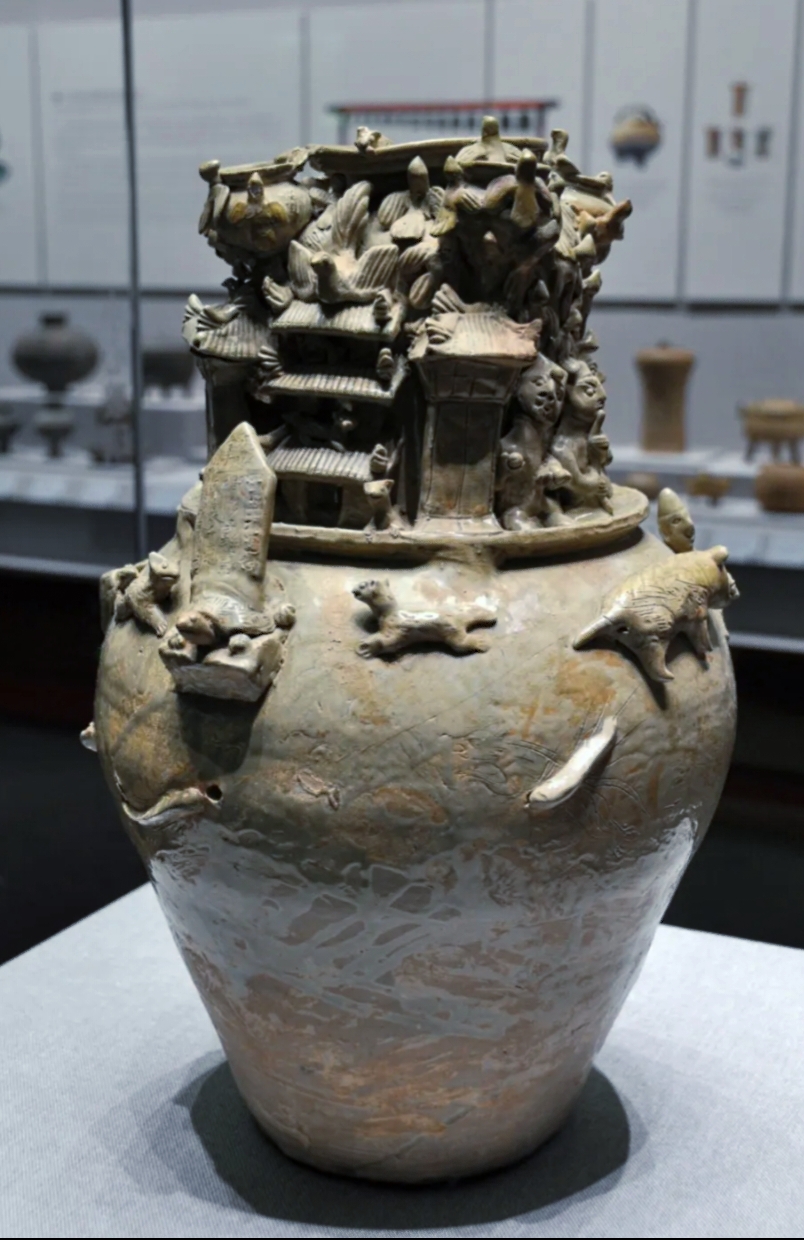 |
| This granary jar, unearthed in the late 1930s from a Three Kingdoms-period Wu tomb in Shaoxing, Zhejiang, was classified in 2013 as a national artifact prohibited from being exhibited abroad. It features intricate sculpted decorations, with a celadon-glazed lower jar and an upper section adorned with five interconnected jars, birds, animals, and human figures. The jar also includes a stele inscription (3rd year of Yong an) dating to 260 CE, making it one of the earliest known dated ceramics. Originating from Eastern Han five-linked jars, it was used as a burial object in the Three Kingdoms and Western Jin periods. Its detailed carvings depict scenes of abundant harvests and lively rural life, reflecting the agricultural prosperity of Jiangnan over 1,700 years ago. |
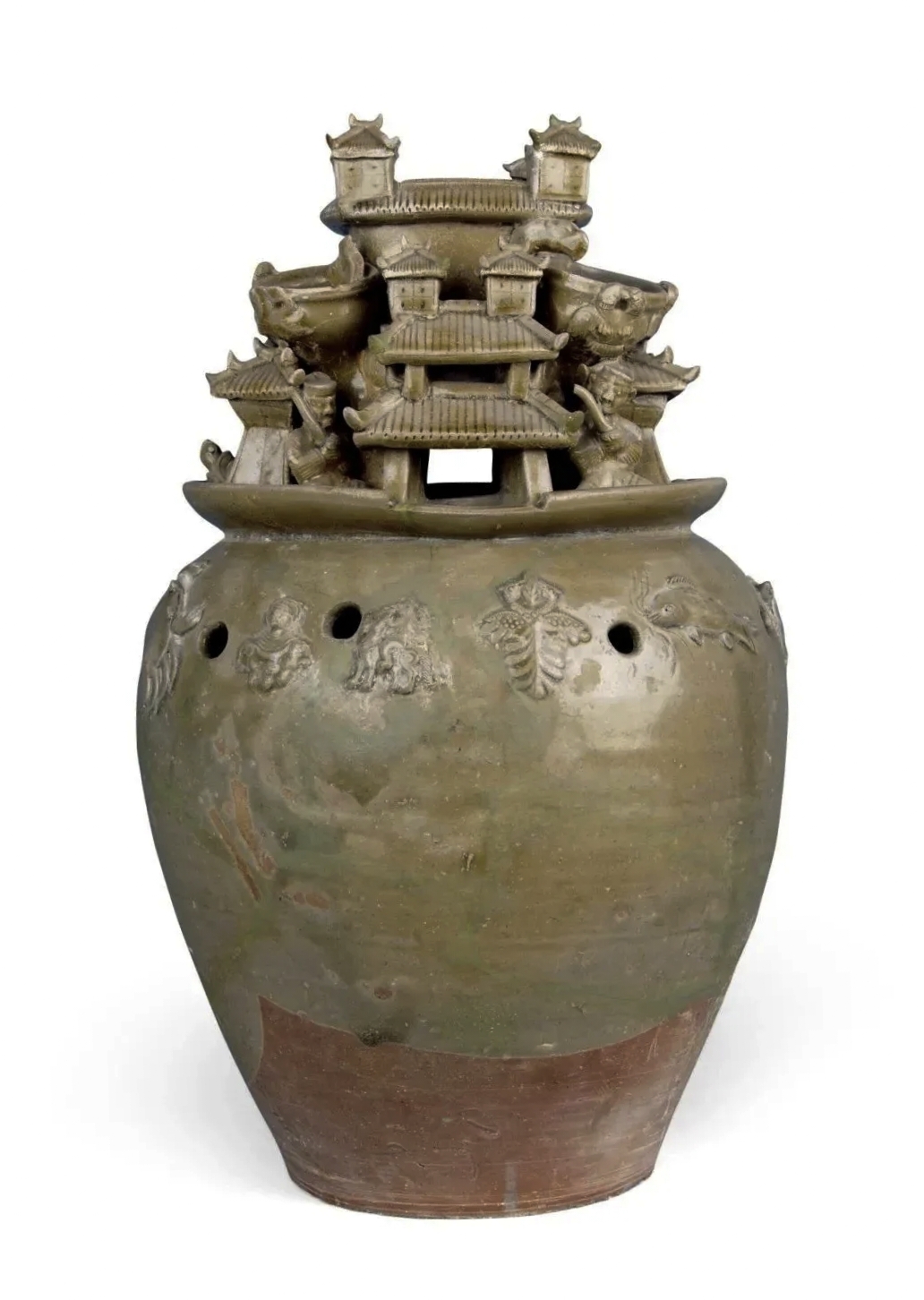 |
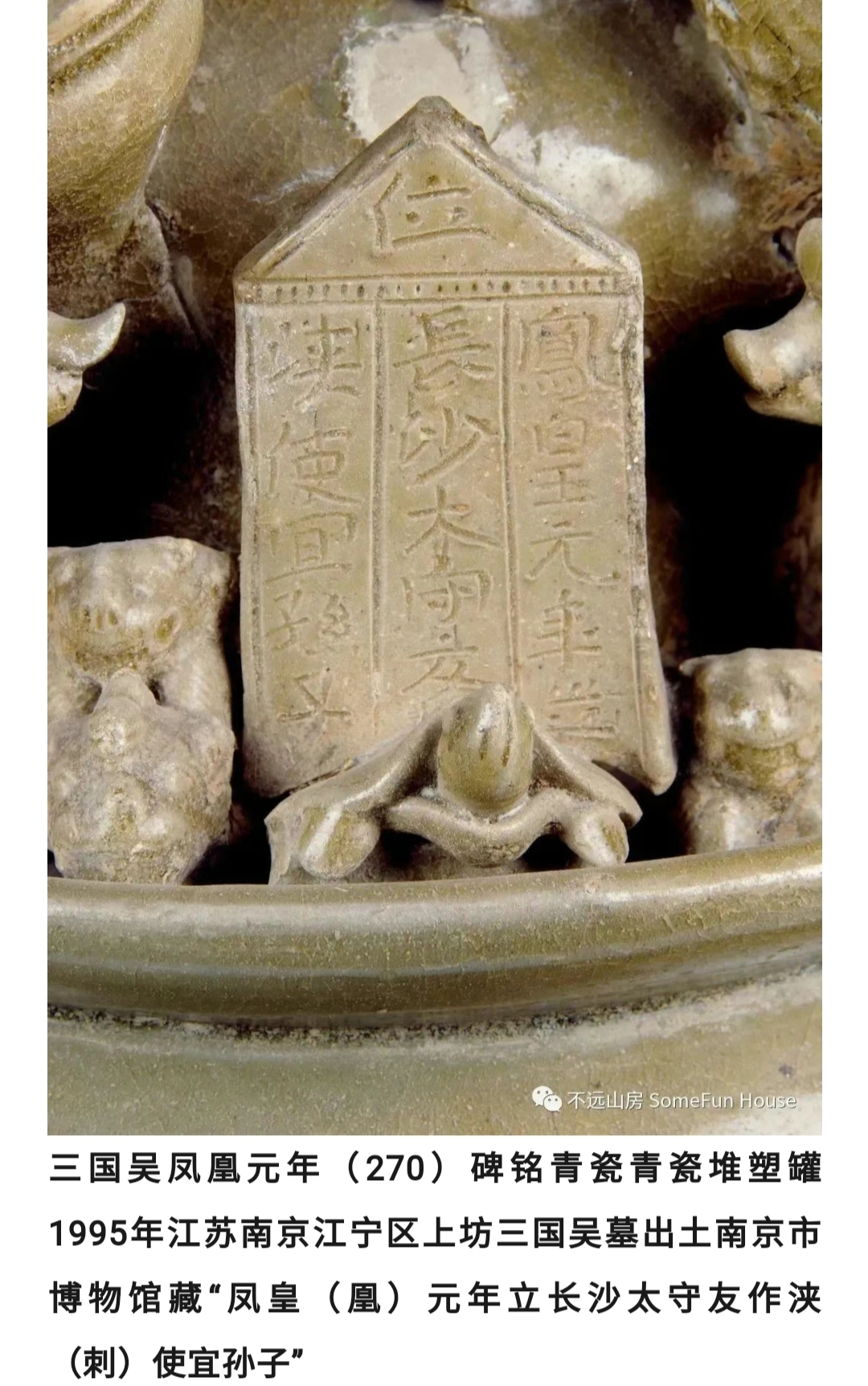 |
|
Celadon Stacked-sculpture Funerary Urn with Inscription
from the First Year of Fenghuang (Phoenix) Reign (270 CE), Wu
Kingdom, Three Kingdoms Period. Excavated in 1995 from a Wu
Kingdom tomb at Shangfang, Jiangning District, Nanjing City,
Jiangsu Province. Currently in the collection of Nanjing
Municipal Museum.
The inscription reads:
"Erected in the First Year of Fenghuang (Phoenix) Reign
[270 CE], [Commissioned by] You Zuo, Grand Administrator of
Changsha and Provincial Inspector (Cishi), for the Eternal
Benefit of Descendants."
|
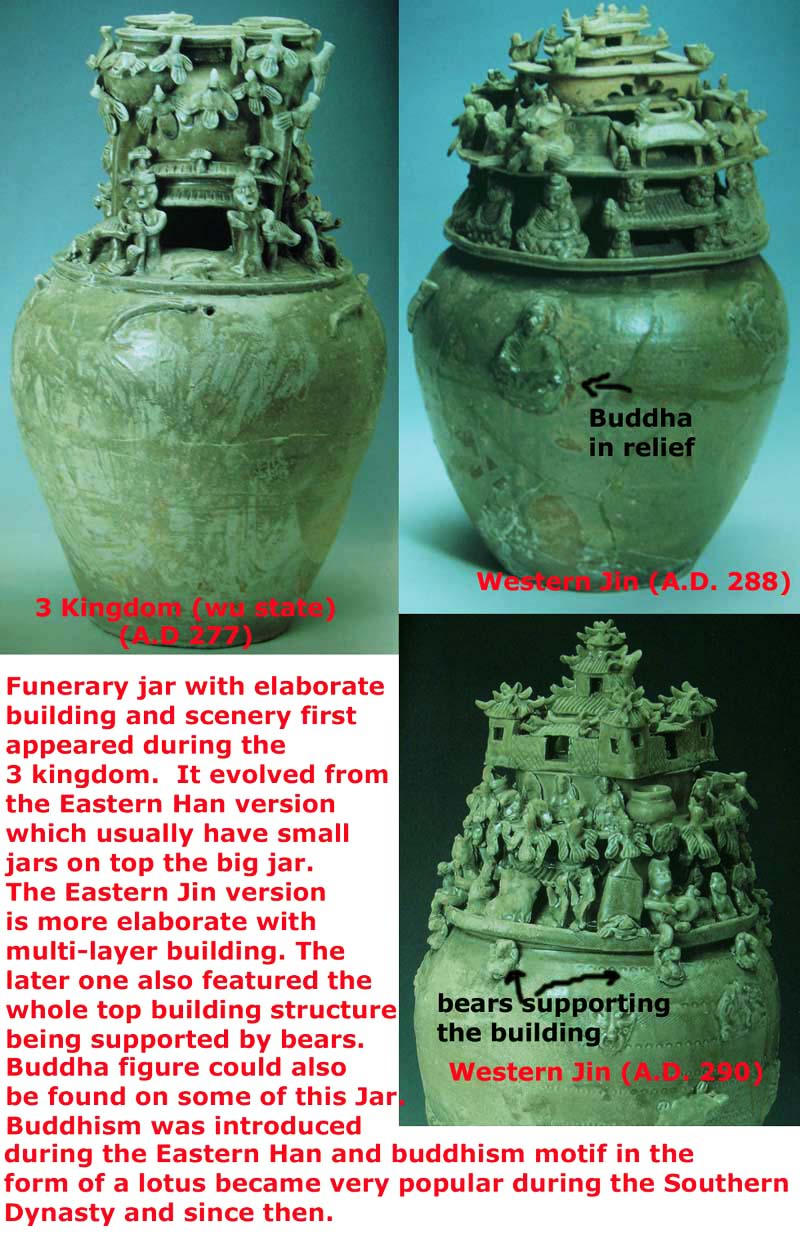 |
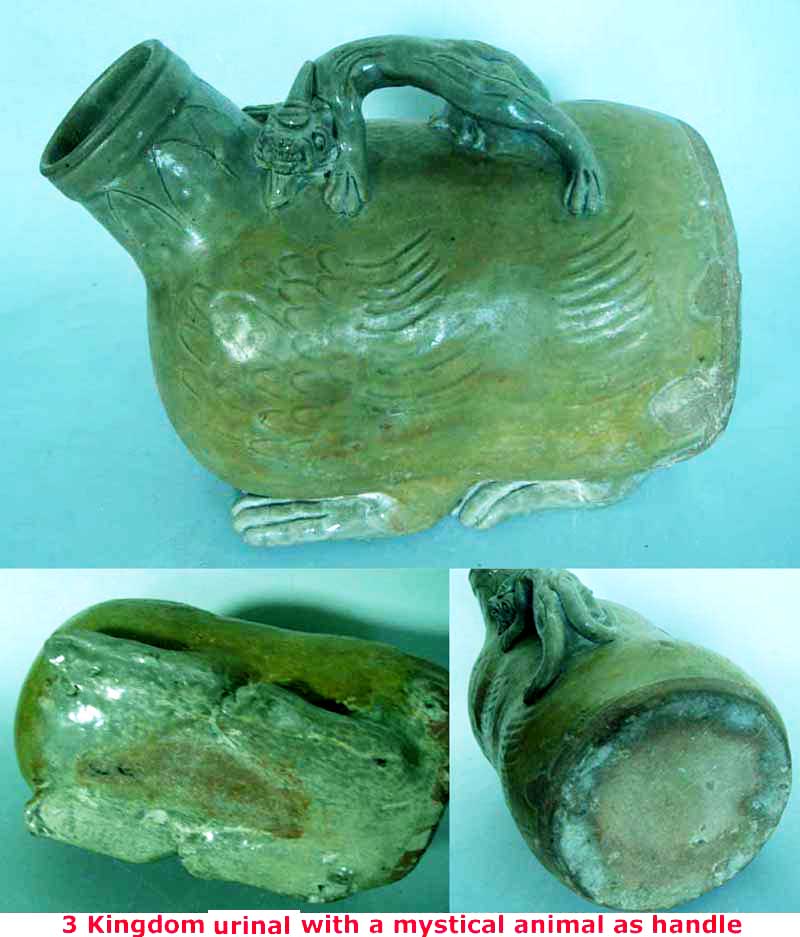 |
3. Western Jin Prosperity and Commercialization
- Expansion of Production and Artistic Creativity: Yue Kiln production flourished during the Western Jin, with vessels featuring thicker gray clay bodies, bluish-gray glazes, and increasingly intricate carved and sculpted decorations. The production of daily-use and burial wares dominated, with censers becoming signature forms. The political and cultural center around Nanjing became a major market for Yue Kiln wares. A wide variety of animal-shaped vessels—chicken-head pots, beast-shaped zun, ram-shaped containers, lion-shaped vessels, and bear-shaped lamps—reflect the period's creative vitality.
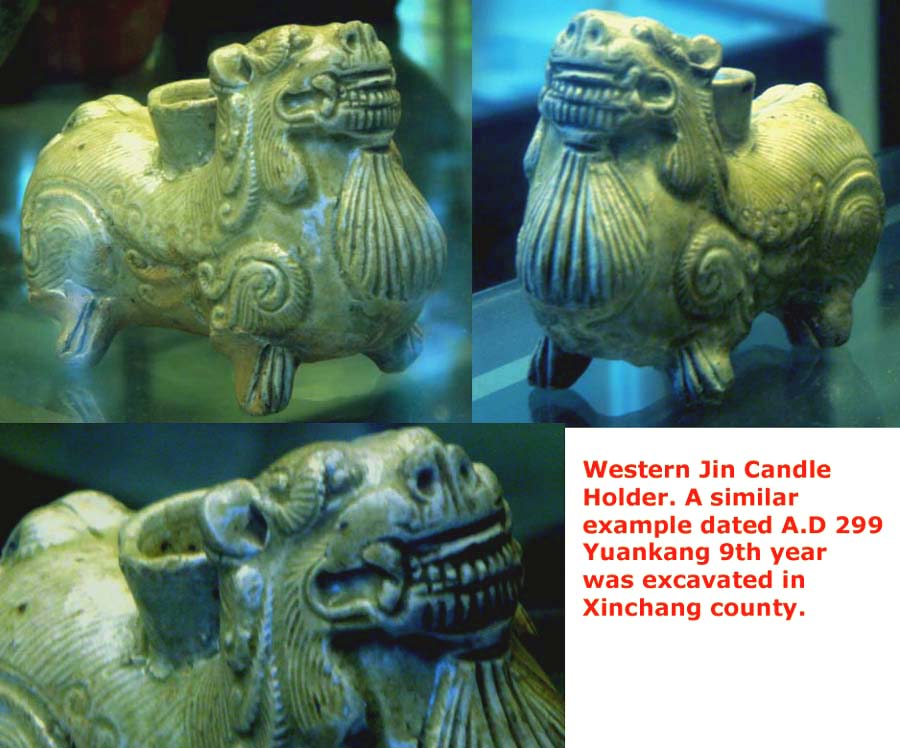 |
| After the opening of the Silk Road, mythical creature motifs such as Bixie (auspicious beasts) based on lion prototypes entered China, appearing on stone carvings, porcelain, gold and silverware, and silk textiles, becoming testaments to cultural exchanges between China and the West. Celadon lion-shaped vessels first appeared during the Wu Kingdom of the Three Kingdoms period, became prevalent in the Western Jin Dynasty, and were occasionally found during the Eastern Jin Dynasty. |
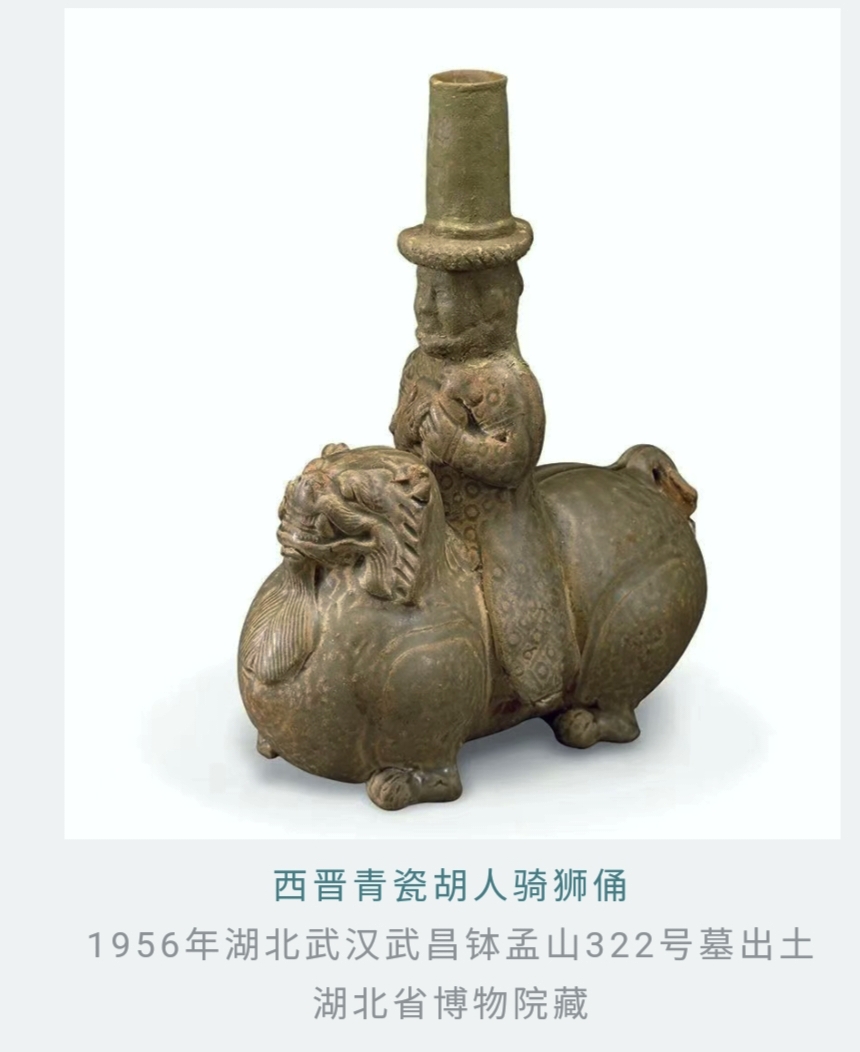 |
| Western Jin vessel in the form of a foreign looking man astride a lion. |
|
|
| The censer is fully coated in a lustrous celadon glaze, creating an even and smooth surface. It comprises two components: an incense burner and a three-legged tray. The burner is shaped like a hollow flower bud, featuring a constricted neck, sloping shoulders, and a rounded belly. Its walls are intricately pierced with three tiers of floral and leaf-shaped smoke vents, while a doorway is carved into the main body. The burner is elevated on three beast-hoof-shaped legs, which seamlessly connect to the supporting tray below. |
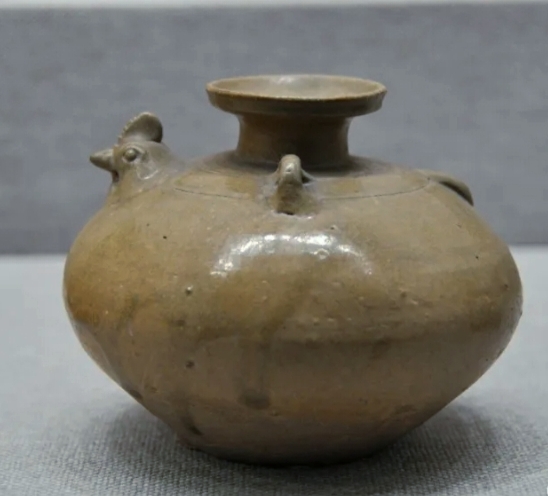 |
| During the Western Jin Dynasty, chicken-head jars were characterized by a flatter belly, shorter neck, chicken head without distinct neck, and a small stubby tail. |
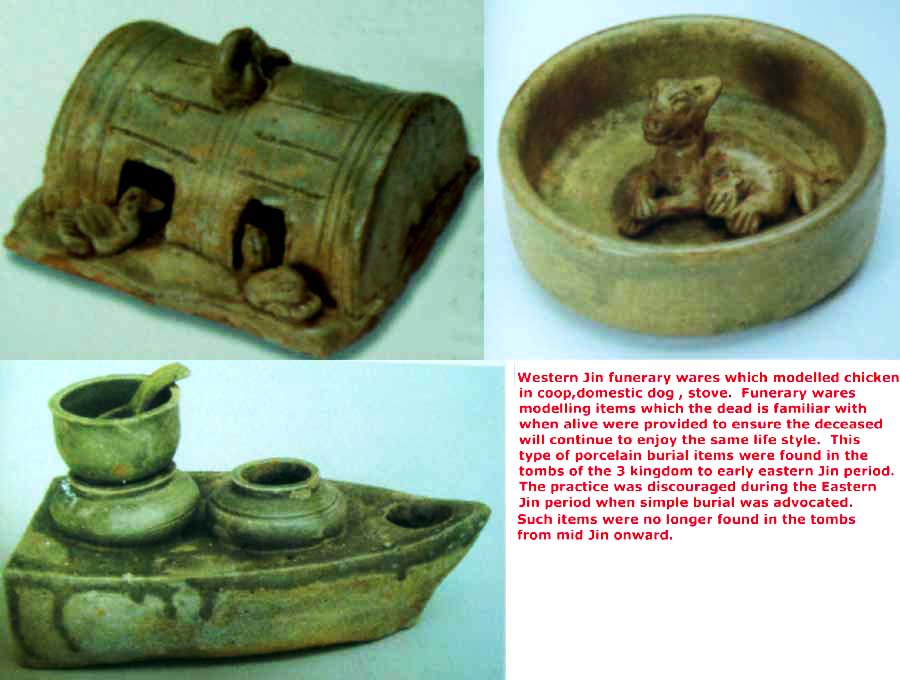 |
4. Simplification in the Eastern Jin to Southern Dynasties (317–589 CE)
- Shift Toward Utilit and Evolving Aesthetics: By the Eastern Jin, celadon forms became simpler and more focused on daily utensils, such as lamps, bowls, and inkstones. Decoration was restrained, often limited to string patterns. In the Southern Dynasties, lotus petal motifs and dense brown speckling became common. Two main clay and glaze types developed: fine gray-bodied wares with classic celadon glaze, and coarser yellowish-bodied wares with yellow-green glaze.
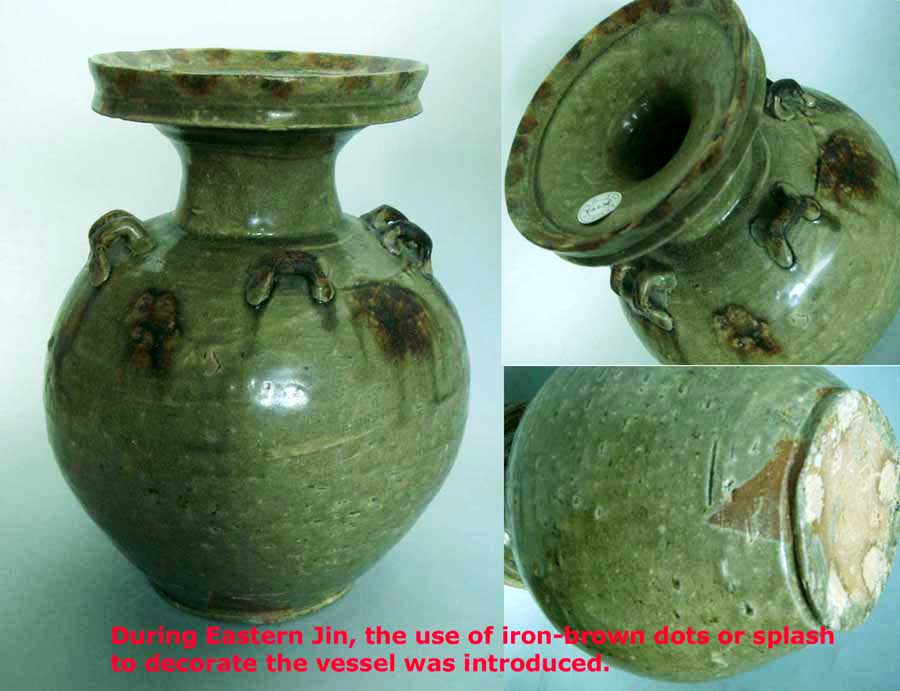 |
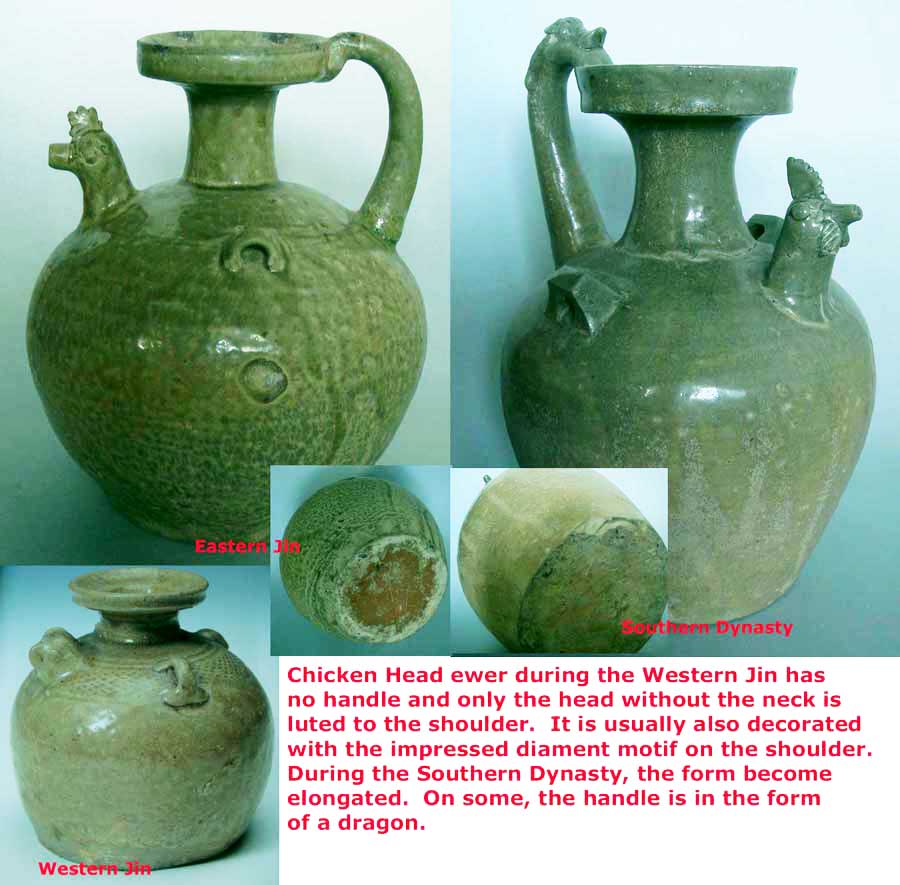 |
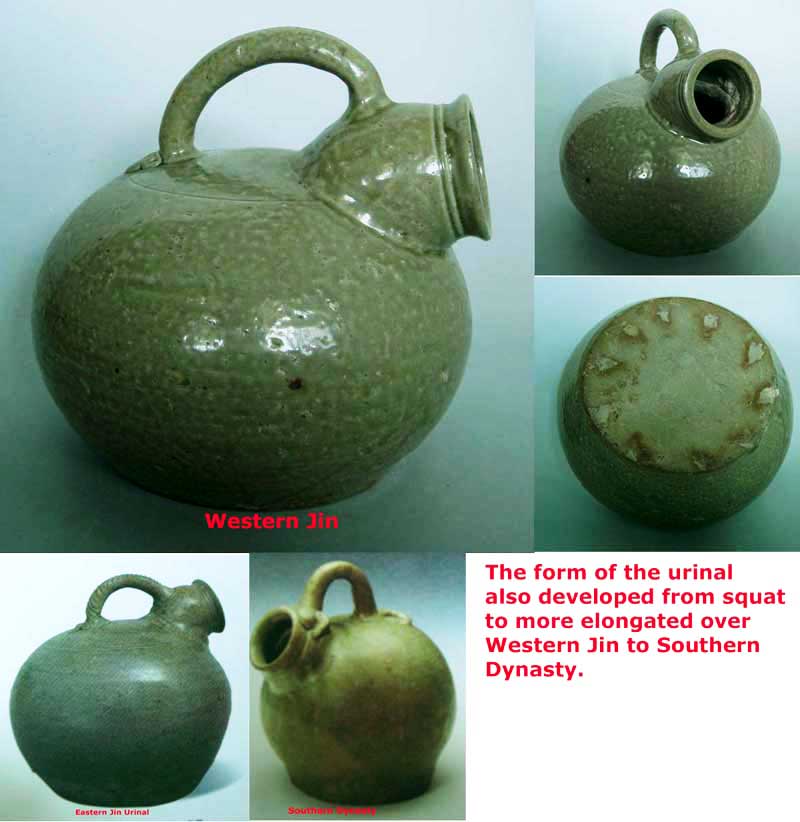 |
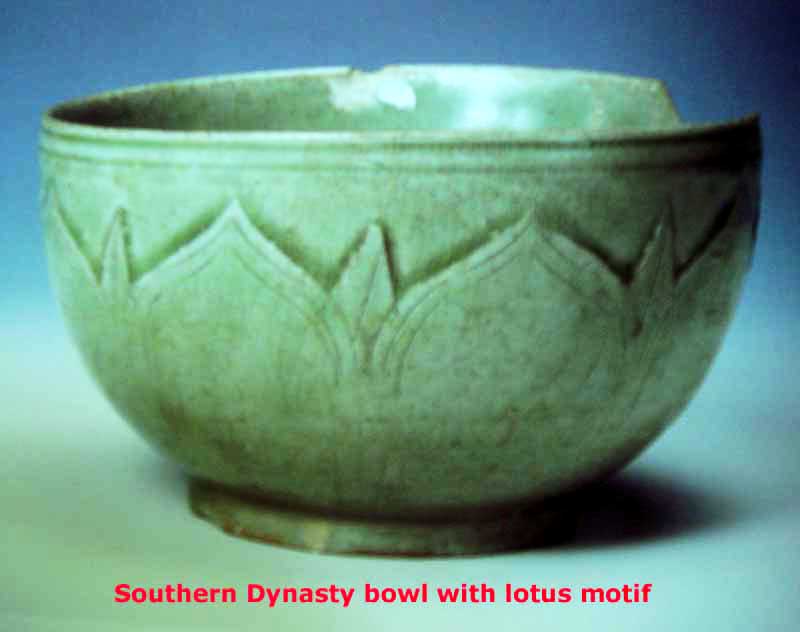 |
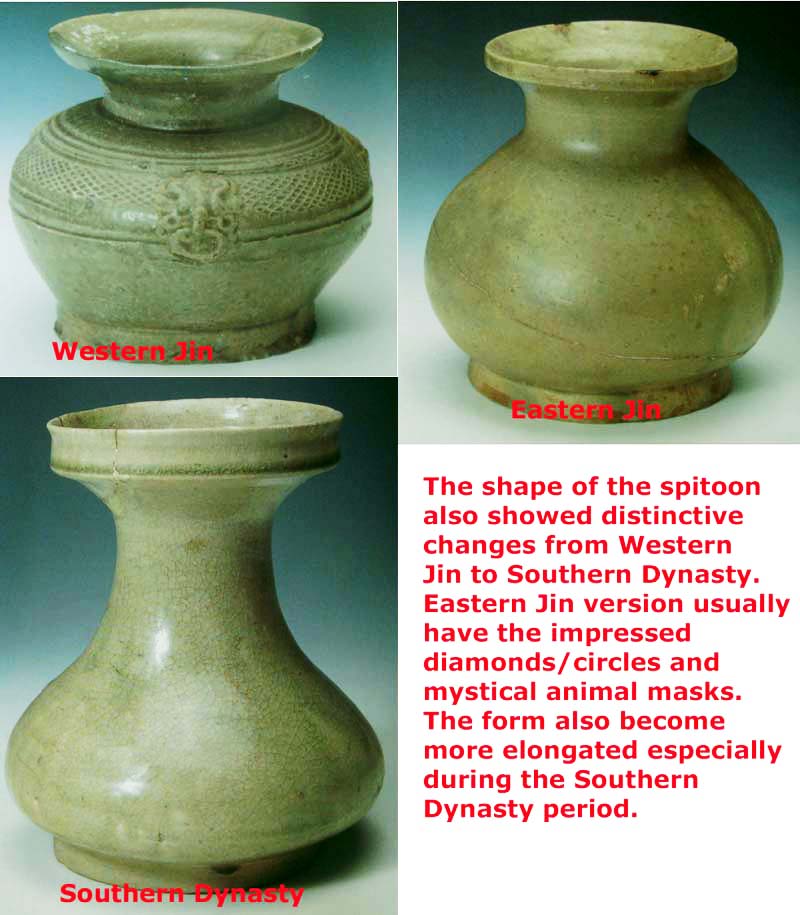 |
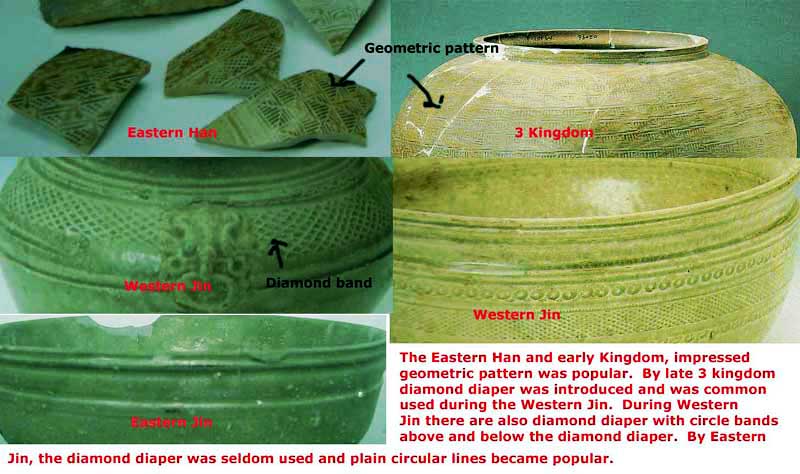 |
5. Peak and Decline (Sui-Tang to Song Dynasties)
- Golden Age: There was a general decline in quality and quantity of production during Sui and Early Tang periods. However, during Mid-Tang period, quality and production recovered and by late Tang period reached new height of Yue Kiln celadon production, characterized by technical sophistication and aesthetic refinement.
- Gradual Decline: By the mid-Northern Song, Yue celadon faced stiff competition from rising kiln centers like Longquan and Ding, leading to a decline in both quality and prominence. Nevertheless, production continued into the Southern Song, maintaining regional significance.
For more on Tang to Song Dynasties Yue ware, please read this.
Cultural and Technological Significance
- Technical Mastery: Innovations such as the dragon kiln and advanced glaze chemistry, particularly iron-reduction techniques, enabled celadon’s hallmark translucency and delicate bluish-green hues.
- Artistic Reflection of Society: From ritual vessels of the Warring States to the playful animal figurines of the Jin, Yue Kiln ceramics embody evolving societal values, blending functionality with symbolic and artistic expression.
- Economic and Cultural Impact: Inscriptions and widespread trade networks attest to Yue celadon's economic role beyond local markets, while its prevalence in burial contexts underscores its cultural and spiritual importance.
Conclusion
The Yue Kiln's enduring legacy lies in its seamless fusion of technical mastery and artistic evolution. From its primitive beginnings to the sophisticated celadon wares that shaped Chinese ceramic traditions for millennia, the Yue Kiln remains a cornerstone of China’s artistic and cultural heritage. Ongoing discoveries, such as the Warring States kiln sites, continue to deepen our understanding of early porcelain development, reaffirming Yue celadon's pivotal role in the history of global ceramics.
Written by : NK Koh 19 Mar 2025